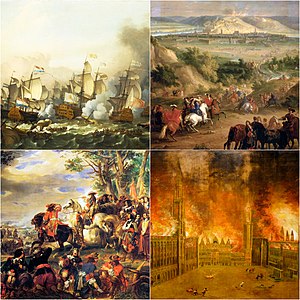
Back حرب التسع سنوات Arabic حرب التسع سنين ARZ Guerra de los Nueve Años AST Doqquzillik müharibə Azerbaijani دوقوز ایل ساواشی AZB Вайна Аўгсбургскай лігі Byelorussian Деветгодишна война Bulgarian Brezel an Nav Bloaz Breton Guerra dels Nou Anys Catalan Devítiletá válka Czech
The Nine Years' War[c] was a European great power conflict from 1688 to 1697 between France and the Grand Alliance.[d] Although largely concentrated in Europe, fighting spread to colonial possessions in the Americas, India, and West Africa. Related conflicts include the Williamite war in Ireland, and King William's War in North America.
Louis XIV of France emerged from the Franco-Dutch War in 1678 as the most powerful monarch in Europe. Using a combination of aggression, annexation, and quasi-legal means, he then set about extending his gains to strengthen France's frontiers, culminating in the 1683 to 1684 War of the Reunions. The Truce of Ratisbon guaranteed these new borders for twenty years, but concerns among European Protestant states over French expansion and anti-Protestant policies led to the creation of the Grand Alliance, headed by William of Orange.
In September 1688 Louis led an army across the Rhine to seize additional territories beyond it. This move was designed to extend his influence and pressure the Holy Roman Empire into accepting his territorial and dynastic claims. However, Leopold I, Holy Roman Emperor and German princes supported the Dutch in opposing French aims, while the November 1688 Glorious Revolution secured English resources and support for the Alliance. Over the next few years, fighting focused around the Spanish Netherlands, the Rhineland, the Duchy of Savoy, and Catalonia. Although engagements generally favoured Louis' armies, neither side was able to gain a significant advantage, and by 1696 the main belligerents were financially exhausted, making them keen to negotiate a settlement.
Under the terms of the 1697 Peace of Ryswick, French control over the entirety of Alsace was officially recognized, but Lorraine and gains on the right bank of the Rhine were relinquished and restored to their rulers. Louis XIV also recognised William III as the rightful king of England, while the Dutch acquired barrier fortresses in the Spanish Netherlands to help secure their borders and were granted a favorable commercial treaty. However, both sides viewed the peace as only a pause in hostilities, since it failed to resolve who would succeed the ailing and childless Charles II of Spain as ruler of the Spanish Empire, a question that had dominated European politics for over 30 years. This would lead to the War of the Spanish Succession in 1701.
Cite error: There are <ref group=note> tags on this page, but the references will not show without a {{reflist|group=note}} template (see the help page).
- ^ Glete (2001), p. 156.
- ^ Stapleton (2003), p. 189.
- ^ Stapleton (2003), p. 143.
- ^ Van Nimwegen (2020), p. 59.
- ^ a b Wilson (2016), p. 461.
- ^ Stapleton (2003), pp. 88–89.
- ^ Stapleton (2003), p. 99.
- ^ a b c Van Nimwegen 2020, p. 67.
- ^ Lynn (2020), p. 167.
- ^ Bartlett 1997, p. 190.
- ^ Chandler 2003, p. 35.
- ^ Levy, Jack S (1983). War in the Modern Great Power System: 1495 to 1975. University Press of Kentucky. p. 90.
Cite error: There are <ref group=lower-alpha> tags or {{efn}} templates on this page, but the references will not show without a {{reflist|group=lower-alpha}} template or {{notelist}} template (see the help page).
